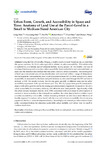Urban Form, Growth, and Accessibility in Space and Time: Anatomy of Land Use at the Parcel-Level in a Small to Medium-Sized American City
| dc.contributor.author | Zhou, L | |
| dc.contributor.author | Shen, G | |
| dc.contributor.author | Wu, Y | |
| dc.contributor.author | Brown, Robert | |
| dc.contributor.author | Chen, T | |
| dc.contributor.author | Wang, C | |
| dc.date.accessioned | 2019-02-13T11:07:57Z | |
| dc.date.available | 2019-02-13T11:07:57Z | |
| dc.date.issued | 2018-12 | |
| dc.identifier.issn | 1937-0695 | |
| dc.identifier.issn | 2071-1050 | |
| dc.identifier.other | ARTN 4572 | |
| dc.identifier.uri | http://hdl.handle.net/10026.1/13300 | |
| dc.description.abstract |
<jats:p>Using the City of Corvallis, Oregon, a small to medium sized American city, as a test-bed, this paper examines the City’s urban growth in relation to urban accessibility. This relationship is explored in an anatomic spatial-temporal fashion, taking account of: the number and size of developed land use parcels over time; urban accessibility from residential to non-residential land use areas; and the statistical relationships between urban form and urban accessibility. This investigation of land use is structured around use-classification and examined within a range of dimensional and demographic measurements over 5-year time periods from 1853 to 2014; concurrently, urban accessibility is measured by the least-cost path distance as calculated through the OD cost matrix analysis in GIS. The results indicate that the city grew spatially at different rates and its urban accessibility experienced both ups and downs over time. The city’s population growth corresponded closely with urban growth and its decreasing population density negatively impacted on the city’s urban accessibility to commerce, industry, and office for most time periods. Significantly, while the urban density increased steadily after 1950s concurrent with an increase in urban sprawl, in contrast to previous studies on the metropolitan condition, the urban density had no evident impact on urban accessibility in Corvallis. Instead, increasing the land-use mix was a more effective and feasible approach to reduce urban travel path distance and enhance accessibility than increasing population density or urban development density. Accordingly, this research provides evidence-based policy recommendations for planning sustainable urban mobility and urban form in small to medium-sized cities.</jats:p> | |
| dc.format.extent | 4572-4572 | |
| dc.language | en | |
| dc.language.iso | en | |
| dc.publisher | Mary Ann Liebert | |
| dc.subject | urban form | |
| dc.subject | urban growth | |
| dc.subject | accessibility | |
| dc.subject | land use and parcel | |
| dc.subject | space and time | |
| dc.subject | scatterplot matrix and correlation | |
| dc.title | Urban Form, Growth, and Accessibility in Space and Time: Anatomy of Land Use at the Parcel-Level in a Small to Medium-Sized American City | |
| dc.type | journal-article | |
| dc.type | Journal Article | |
| plymouth.author-url | http://gateway.webofknowledge.com/gateway/Gateway.cgi?GWVersion=2&SrcApp=PARTNER_APP&SrcAuth=LinksAMR&KeyUT=WOS:000455338100238&DestLinkType=FullRecord&DestApp=ALL_WOS&UsrCustomerID=11bb513d99f797142bcfeffcc58ea008 | |
| plymouth.issue | 12 | |
| plymouth.volume | 10 | |
| plymouth.publication-status | Published online | |
| plymouth.journal | Sustainability | |
| dc.identifier.doi | 10.3390/su10124572 | |
| plymouth.organisational-group | /Plymouth | |
| plymouth.organisational-group | /Plymouth/Faculty of Arts, Humanities and Business | |
| plymouth.organisational-group | /Plymouth/Faculty of Arts, Humanities and Business/School of Art, Design and Architecture | |
| plymouth.organisational-group | /Plymouth/REF 2021 Researchers by UoA | |
| plymouth.organisational-group | /Plymouth/REF 2021 Researchers by UoA/UoA13 Architecture, Built Environment and Planning | |
| plymouth.organisational-group | /Plymouth/Users by role | |
| plymouth.organisational-group | /Plymouth/Users by role/Academics | |
| dcterms.dateAccepted | 2018-11-30 | |
| dc.rights.embargodate | 2019-12-20 | |
| dc.identifier.eissn | 2071-1050 | |
| dc.rights.embargoperiod | Not known | |
| rioxxterms.versionofrecord | 10.3390/su10124572 | |
| rioxxterms.licenseref.uri | http://www.rioxx.net/licenses/all-rights-reserved | |
| rioxxterms.licenseref.startdate | 2018-12 | |
| rioxxterms.type | Journal Article/Review |


